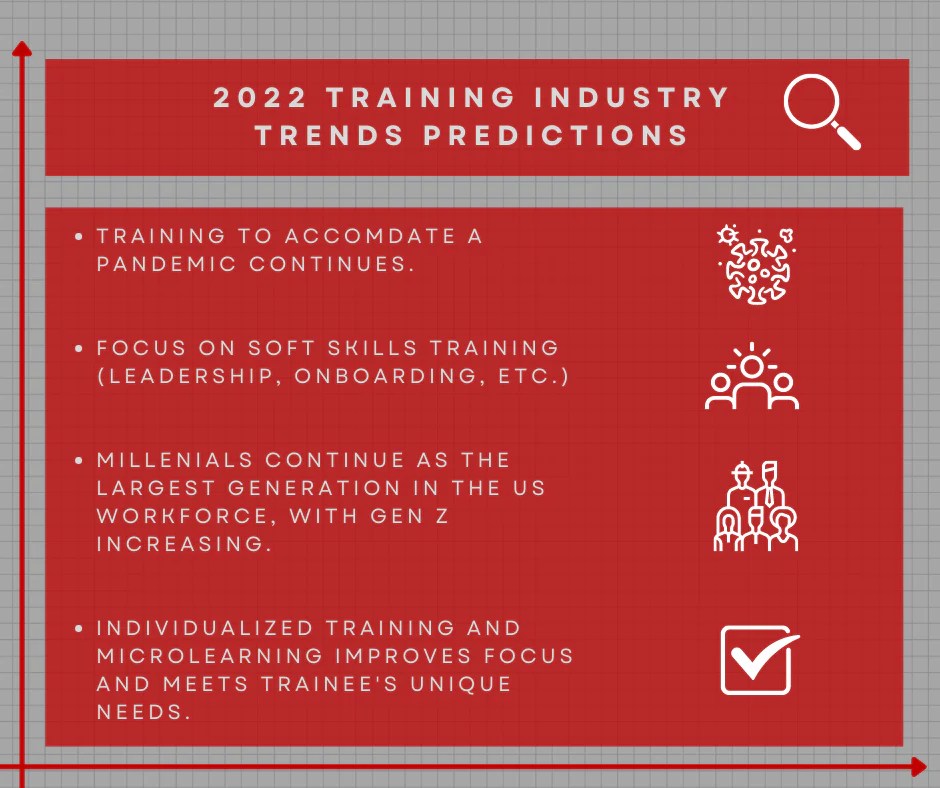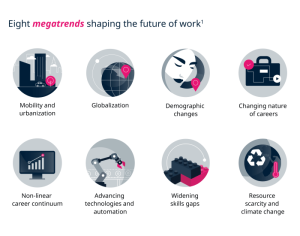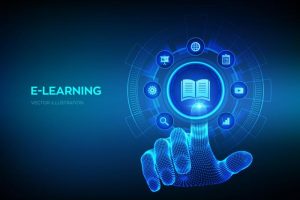
Diving into Education and training industry trends, get ready to explore the exciting advancements, emerging technologies, and global perspectives that are shaping the future of education and training. From the impact of remote learning to the potential of blockchain, this topic promises an engaging journey through the evolving landscape of the industry.
As we delve deeper, we will uncover the key skills in demand, shifting learning approaches, and future predictions that will revolutionize how we learn and teach. Let’s embark on this captivating exploration together!
Current Trends in the Education and Training Industry
In today’s fast-paced world, the education and training industry is experiencing significant advancements that are reshaping the way we learn and teach. Technology has played a crucial role in revolutionizing educational practices, making learning more accessible and engaging than ever before. Additionally, the rise of remote learning has had a profound impact on the industry, allowing individuals to pursue education from anywhere in the world.
Advancements in EdTech
Technology has transformed the education landscape, with the integration of Artificial Intelligence (AI), Virtual Reality (VR), and Augmented Reality (AR) into learning platforms. These technologies have made learning more interactive and personalized, catering to individual learning styles and preferences. For example, AI-powered adaptive learning systems can analyze student performance data to provide personalized recommendations and feedback, enhancing the overall learning experience.
Remote Learning Revolution
The shift to remote learning, accelerated by the global pandemic, has revolutionized the way education is delivered. Online learning platforms, video conferencing tools, and virtual classrooms have become essential components of the educational experience. This has not only made education more flexible and convenient but has also opened up opportunities for lifelong learning and upskilling for individuals of all ages.
Emerging Technologies in Education and Training
Artificial intelligence (AI), virtual reality (VR), and blockchain are revolutionizing the education and training industry, offering new possibilities for personalized learning, immersive experiences, and credential verification.
Artificial Intelligence in Personalized Learning
Artificial intelligence plays a crucial role in personalized learning by analyzing data and adapting educational content to meet the individual needs of students. AI-powered platforms can track student progress, identify learning gaps, and provide tailored recommendations for improvement.
Virtual Reality for Immersive Educational Experiences
Virtual reality technology allows students to immerse themselves in realistic and interactive learning environments, enhancing engagement and retention. By simulating hands-on experiences, VR helps learners understand complex concepts and apply knowledge in practical scenarios.
Blockchain in Verifying Credentials
Blockchain technology offers a secure and decentralized way to verify credentials, such as certificates, diplomas, and skills. By storing educational records on a tamper-proof ledger, blockchain ensures the authenticity and integrity of academic achievements, making it easier for employers and institutions to validate qualifications.
Skills in Demand in the Education and Training Sector
In today’s rapidly changing educational landscape, educators need to possess a diverse set of skills to effectively adapt to modern teaching methods. Digital literacy, soft skills training, and the ability to incorporate emerging technologies are crucial for success in the education and training sector.
Key Skills Educators Need to Adapt to Modern Teaching Methods
Educators must be adaptable and willing to embrace new teaching techniques and technologies to enhance student learning outcomes. Some key skills in demand include:
- Technological Proficiency: Educators should be comfortable using educational technology tools to create engaging learning experiences.
- Collaboration and Communication: The ability to collaborate with colleagues and communicate effectively with students is essential for creating a positive learning environment.
- Critical Thinking: Educators need to encourage students to think critically and solve problems creatively.
- Adaptability: With the rapid changes in education, educators must be flexible and open to trying new approaches to teaching.
The Importance of Digital Literacy for Educators and Learners
Digital literacy is no longer optional but a necessity in today’s education system. Educators must be proficient in using digital tools to enhance learning experiences and prepare students for the digital world. Similarly, learners need to develop digital literacy skills to navigate online resources, collaborate effectively, and critically evaluate information.
The Rise of Soft Skills Training in Educational Curricula
Soft skills, such as communication, teamwork, and emotional intelligence, are increasingly recognized as essential for success in the modern workplace. Educational institutions are incorporating soft skills training into their curricula to ensure that students are well-rounded individuals equipped to thrive in diverse professional settings. By focusing on developing these skills, educators can better prepare students for the challenges of the future job market.
Shifts in Learning Approaches
Traditional classroom learning and online learning platforms have been two prominent methods of education delivery. While traditional classroom learning involves face-to-face interactions with teachers and peers, online learning platforms provide flexibility and accessibility through digital resources and virtual classrooms.
Comparison between Traditional Classroom Learning and Online Learning Platforms
- Traditional Classroom Learning:
- Structured environment with set class timings and physical presence of teachers.
- Interactive discussions and real-time feedback from teachers.
- Opportunity for hands-on activities and group projects.
- Online Learning Platforms:
- Flexible scheduling allowing students to learn at their own pace.
- Access to a wide range of digital resources and multimedia content.
- Virtual classrooms and online forums for discussions and collaboration.
Effectiveness of Gamification in Education
Gamification in education involves incorporating game elements such as points, badges, and leaderboards into the learning process to enhance engagement and motivation among students. It can make learning more interactive and enjoyable, leading to improved retention of information and better learning outcomes.
Rise of Microlearning and Its Impact on Knowledge Retention
Microlearning is a learning approach that delivers content in small, bite-sized chunks to cater to the shrinking attention spans of learners. This method focuses on providing specific and targeted information in short intervals, making it easier for students to digest and retain knowledge. With the rise of mobile learning and on-the-go education, microlearning has gained popularity for its effectiveness in enhancing knowledge retention and application.
Global Perspectives on Education and Training

When looking at education and training on a global scale, it becomes evident that there are significant differences in educational systems worldwide. These differences stem from cultural, political, economic, and historical factors that shape the way education is structured and delivered in each country.
Educational Systems Worldwide
- In some countries, education is highly centralized, with a national curriculum dictating what is taught in schools. In contrast, other countries have decentralized systems, allowing more flexibility at the local level.
- Furthermore, the length of compulsory education varies from country to country, with some requiring only a few years of schooling while others mandate education up to a certain age.
- The emphasis on standardized testing also differs globally, with some countries placing a heavy focus on exam results while others prioritize holistic learning outcomes.
Cultural Diversity and Educational Practices
- Cultural diversity plays a crucial role in shaping educational practices, as it influences teaching methods, curriculum content, and student-teacher interactions.
- For example, in countries with a collectivist culture, group work and collaboration are often prioritized in the classroom, whereas individual achievement may be more emphasized in individualistic societies.
- Moreover, cultural values and beliefs can impact the topics covered in the curriculum, with some subjects being deemed more important or relevant based on cultural norms.
International Collaborations in Education
- International collaborations in education and training have become increasingly common, as educators recognize the value of sharing knowledge and resources across borders.
- Partnerships between universities, research institutions, and governments allow for the exchange of ideas, best practices, and innovative approaches to education.
- These collaborations not only benefit students and teachers but also contribute to the advancement of education as a whole, promoting global understanding and cooperation.
Future Predictions for the Education and Training Industry

The education and training industry is poised to undergo significant changes in the next decade as new technologies continue to emerge and shape the way we learn. These changes will not only impact the methods of teaching and learning but also the roles of educators and the overall sustainability of the education sector.
Impact of Automation on Teaching Roles
Automation is expected to revolutionize the education and training industry by streamlining administrative tasks, personalizing learning experiences, and enabling more efficient assessment methods. With the rise of artificial intelligence and machine learning, teachers may find themselves taking on more of a facilitator role rather than traditional lecturers. This shift will require educators to adapt to new technologies, embrace digital tools, and focus more on guiding students through personalized learning pathways.
Sustainability Initiatives in Education for a Greener Future
As the world becomes more environmentally conscious, sustainability initiatives in education will play a crucial role in shaping a greener future. Educational institutions are increasingly integrating sustainability practices into their curriculum, promoting eco-friendly behaviors among students, and reducing their carbon footprint. From implementing renewable energy sources on campus to incorporating environmental education in the curriculum, the education and training industry is moving towards a more sustainable future.
EDUCATION AND REFERENCE
In today’s digital age, leveraging online resources for learning has become increasingly important. The vast amount of information available on the internet can be a valuable tool for education and training purposes. From finding credible sources to conducting effective online research, there are various strategies that can enhance the learning experience.
How to Leverage Online Resources for Learning
When it comes to finding credible online educational resources, it’s essential to look for reputable websites and platforms that are known for providing accurate and up-to-date information. Some tips for finding credible online resources include:
- Check the author or organization behind the content to ensure expertise and credibility.
- Look for references and citations to validate the information provided.
- Consider the domain of the website (.edu, .gov, .org) for reliable sources.
Incorporating digital libraries in learning can offer numerous benefits, such as access to a wide range of resources, including e-books, journals, and research papers. Digital libraries provide convenience and flexibility, allowing learners to access information anytime, anywhere. Strategies for effective online research in education and training include:
- Utilizing advanced search features to narrow down results and find relevant information.
- Verifying the credibility of sources through cross-referencing and fact-checking.
- Organizing and saving information using tools like bookmarks or citation management software.
Final Wrap-Up
In conclusion, Education and training industry trends are constantly evolving, offering endless opportunities for growth and innovation. By embracing new technologies and adapting to changing learning approaches, we can create a brighter future for education worldwide. So, let’s stay curious, open-minded, and ready to embrace the exciting changes ahead in the industry.
FAQ Explained
What are some current trends shaping the Education and Training Industry?
Current trends include advancements in technology, the rise of remote learning, and the impact of digital transformation on educational practices.
How is blockchain being used in the Education and Training sector?
Blockchain technology is being explored for verifying credentials, ensuring transparency, and enhancing the security of educational records.
Why are soft skills training gaining importance in educational curricula?
Soft skills are essential for success in the modern workforce, prompting educators to incorporate them into curricula to prepare students for real-world challenges.





